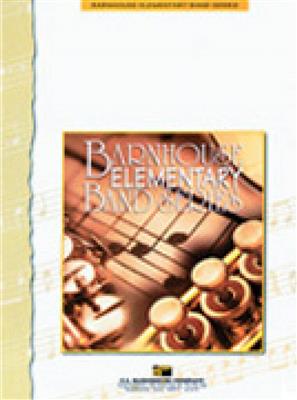Results
-
 £91.99
£91.99Sunscapes - Wilson
This exciting work depicts the lively and sunny nature of the state of Florida. Opening with a brilliant and majestic section highlighting the state's bright and vibrant culture, a flowing melody follows, representing the calming winds and consistent breeze of the state. Dance is a large part of Florida's culture, especially in its southern region, and the 7/8 rhythm captures an Afro-Latin style dance movement. The chorale/hymn section is based on the "Florida Song," which is a traditional school song of many schools, including Florida A&M in Tallahassee. The work then recapitulates and moves toward a driving and joyful conclusion. An excellent contest/festival work!
Estimated dispatch 7-14 working days
-
£91.99
Conversations - Chandler L. Wilson
In the American Declaration of Independence, Thomas Jefferson wrote, "If there's something wrong, those who have the ability to take action have the responsibility to take action..." Chandler Wilson's "Conversations" is based on the idea of conversations that are needed for society to progressively move forward, most profoundly in the areas of racial issues and equality. The music eloquently expresses the importance of considering and respecting the points of view of other's. A musical work which is truly thought-provoking.
Estimated dispatch 7-14 working days
-
£74.99
Oh, My Heart Belongs To Ireland - James Swearingen
It's virtually impossible to visit Ireland without feeling an instant appreciation for the scenic countryside, the endearing charm of its many citizens, and for the deep-rooted history of the country's many crowning achievements. Solo trumpet/cornet (cued for euphonium) packaged with a brief, but optional, vocal solo highlights the beginning and ending of this beautiful piece. The middle section is pure Irish charm with a light and lively theme performed over the drones of bagpipes along with the rudimental sounds of drummers drumming. Simply stunning!
Estimated dispatch 7-14 working days
-
£91.99
Rejoissant! - David Shaffer
As the title suggests, is a celebration of life's conquering obstacles, specifically of the composer's own personal battle against cancer. Written for the Upper Sandusky High School (Ohio) Wind Ensemble and with the thanks from the composer for the support and opportunity to compose this piece during a very difficult period of time, "Rejoissant!" opens with a slower dramatic fanfare in the brass and percussion. The simple but forceful melody is repeated in several forms throughout the piece, including the beautiful and melodic middle section. This exceptionally emotional and energetic composition is suitable for all concerts and especially festival performances.
Estimated dispatch 7-14 working days
-
£86.50
Into Heaven's Hands - David Shaffer
Opening with a lush flute soli, "Into Heaven's Hands" explodes with power, emotion and jubilation in celebration of a beautiful life. The powerful opening gives way to a lyrical and whimsical faster section. David Shaffer's mastery of intricate harmonic progression is on full display throughout this work. A slower, lyrical middle section compliments the entire piece with a balance of pure musical emotion. The percussion writing is simple but very effective in producing an exciting and musical experience for both the players and the listeners. An excellent choice for contest or festival!
Estimated dispatch 7-14 working days
-
£107.50
Audrey Goes Exploring - Holsinger
This "Allegro Moderato" children's march celebrates composer David Holsinger's youngest granddaughter. A delightfully playful melody is passed throughout the piece, section to section, timbre to timbre, trailing off to a surprising last "stinger." Eureka!
Estimated dispatch 7-14 working days
-
£63.99
Hot Fudge Sundae - David Martin
Rock n' Roll sound of the 50's & 60's for the very youngest players. A very unique piece at this level and one that will be extremely popular with students and audiences alike. The band set also includes an optional keyboard part which may be used both as a rehearsal aid or as a performance enhancer with smaller groups. VERY NICE AND STILL LOW IN CALORIES!
Estimated dispatch 7-14 working days
-
 £41.99
£41.99Kidz' Klassix - Ed Huckeby
An entertaining composition containing bits and pieces of 15 famous childen's tunes that are woven together to create an impressive and appealing audience pleaser. The melodies move around so every section gets a chance to shine and Huckeby's extensive use of cues makes it playable with limited instrumentation! A outstanding piece at this grade level! A REAL WINNER!
Estimated dispatch 7-14 working days
-
 £52.99
£52.99Spring Fever - David Shaffer
A delightful composition for beginning bands that is the perfect choice for your spring concert. The winds parts are incredibly easy, consisting of nothing harder than quarter notes while the percussion includes a part to be played on temple blocks or wood blocks. It's cute, it's playable and your students and their parents will love it! Lots of fun!
Estimated dispatch 7-14 working days
-
 £50.50
£50.50Sonic Ascent - Weller
Energize your beginning band with "Sonic Ascent," a triumphant concert opener that fuels a young musician's aspiration to play an instrument. Using just six notes in all the wind parts, bold melodies are shared by each section in the ensemble. The middle section offers opportunities to develop the ensemble's awareness of dynamic and articulation contrast through a series of short call and response motifs between the sections. A brilliant opener for that very first band concert!
Estimated dispatch 7-14 working days
